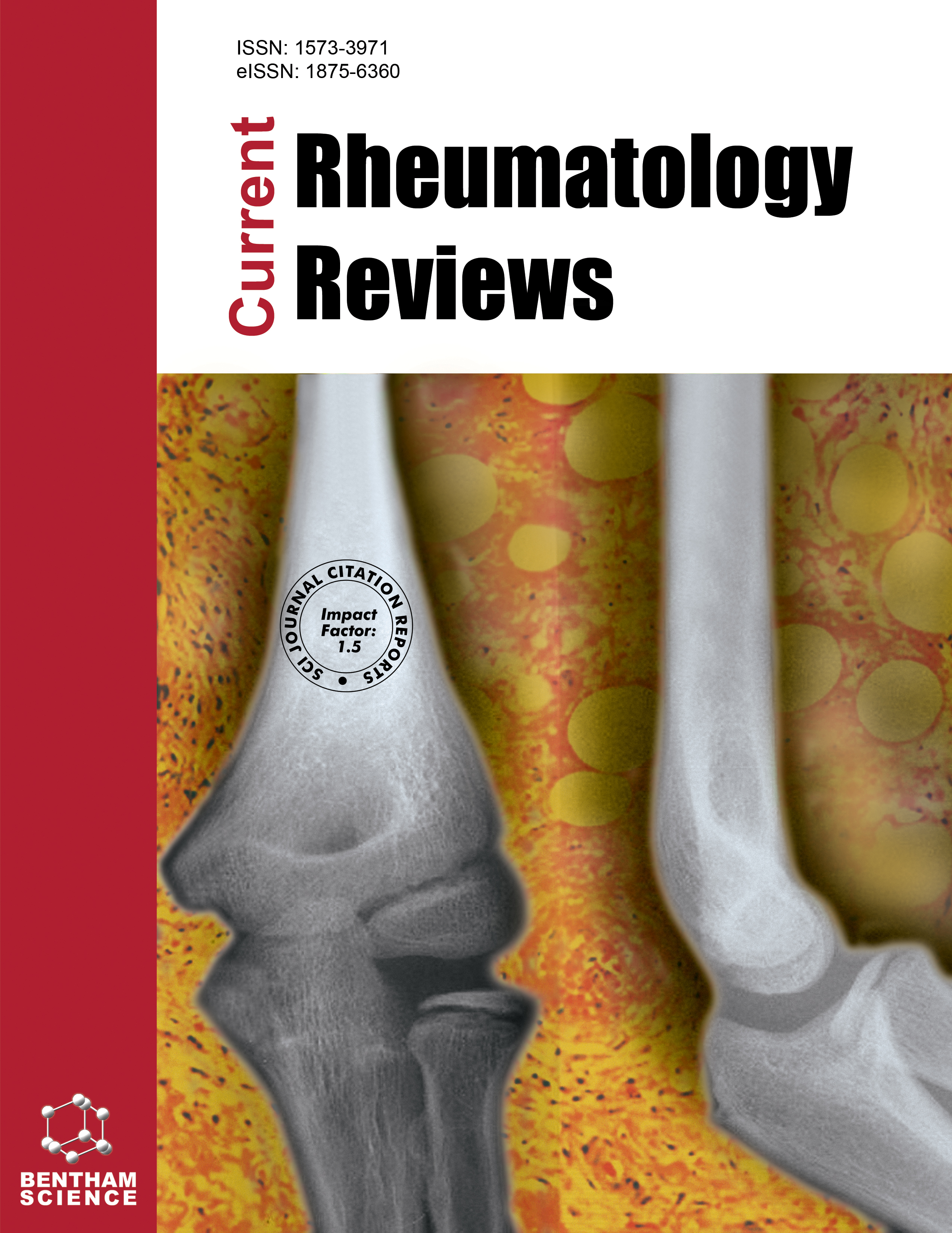- Home
- A-Z Publications
- Current Rheumatology Reviews
- Issue Home
Current Rheumatology Reviews - Current Issue
Volume 21, Issue 2, 2025
-
-
Uncommon Coexistence of Systemic Lupus Erythematosus and Psoriatic Arthritis: A Case-Based Review
More LessCases of systemic lupus erythematosus (SLE) following psoriatic arthritis (PsA) or vice versa are uncommon. Due to the complexity of autoimmune diseases and the rarity of such cases, comprehensive global data on the co-occurrence of these conditions are limited. Moreover, the pathophysiology concerning the coexistence of SLE and PsA has yet to be fully understood. Interestingly, the progression of both disease Read More
-
-
-
Liposomes: An Emerging Strategy for the Effective Treatment of Rheumatoid Arthritis
More LessBackgroundA Liposomal delivery system is a novel and distinguishing way of organized medicine administration. The advancements in liposomal technology allow for controlled drug distribution to treat rheumatoid arthritis effectively. Liposomes are microscopic lipid-based vesicles that have shown promise in transporting substances, such as superoxide dismutase, hemoglobin, erythrocyte interleukin-2, gamma interferon, an Read More
-
-
-
Anti-Inflammatory and Anti-Arthritis Activity of Quercetin: A Comprehensive Review
More LessAuthors: Shikha Chaudhary, Shaweta Sharma, Shivkanya Fuloria and Pramod Kumar SharmaThis comprehensive exploration delves into the multifaceted attributes of quercetin, a flavonoid with extensive health-promoting potential. The review navigates through its fundamental properties, encompassing its chemical structure, classification as a flavonoid, and its natural prevalence in various sources. Addressing solubility, stability, and bioavailability challenges, the investigation delves into innovative isolation techniq Read More
-
-
-
Pharmacogenetic Basis of Response Fluctuations to Methotrexate in Rheumatoid Arthritis: A Narrative Review
More LessAuthors: Mehwish Nawaz Qaisrani, Kulsoom Farhat and Mudassar NoorRheumatoid arthritis is a crippling autoimmune disease affecting more than 18 million people worldwide and thus becoming one of the important contributors to the global health burden. The majority of the affected are females, especially those above the age of 50, but males and younger adults are equally vulnerable. It is a constellation of genetic and environmental factors that interplay to manifest the joint deformities an Read More
-
-
-
Methotrexate - Safe Backbone for the Treatment of Rheumatoid Arthritis
More LessMethotrexate (MTX) is the primarily used disease-modifying antirheumatic drug (DMARD) for the treatment of Rheumatoid Arthritis (RA). MTX is a safe agent, even when used for years - provided that treatment is regularly monitored and prescribers follow some simple rules, such as prescribing tablets of a single strength only. Proper patient education contributes greatly to safe treatment. The knowledge of important Read More
-
-
-
Hormonal Imbalance in Obesity and Arthritis: Points of Contact
More LessAuthors: Sukanya Vijayan and Thirumal MargesanObesity is a growing global health crisis intricately connected to various chronic conditions, including arthritis. This paper explores the intricate web of hormonal changes in the context of obesity and their profound influence on the development and progression of arthritis. Hormones, such as leptin, insulin, cortisol, and estrogen, all altered in obesity, play pivotal roles in inflammation, cartilage degradation, mechanical stress, a Read More
-
-
-
Efficiency of Glucosamine in Treating Temporomandibular Joint Osteoarthritis: A Meta-Analytic Umbrella Review
More LessBackgroundTemporomandibular joint osteoarthritis (TMJ OA) is a chronic disease that is a consequence of undue occlusal forces and is characterized by irreversible damage to the articular surfaces. Symptomatic slow-acting so-called nutraceutical drugs have been proposed as a treatment for osteoarthritis in comparison to non-steroidal anti-inflammatory drugs (NSAIDs). Oral glucosamine and chondroitin, slow-ac Read More
-
-
-
Mixed Connective Tissue Disease (MCTD) in a Girl with Lower Extremities Edema: A Brief Report
More LessAuthors: Niloofar Shashaani, Mehrnoush Hassas Yeganeh, Reza Sinaei, Shima Salehi and Reza ShiariBackgroundMixed Connective Tissue Disease (MCTD) is a rare condition in children, characterized by a high titer of anti-ribonucleoprotein-U1 (anti-U1 RNP) antibodies, often presenting with overlapping features of two or more rheumatologic disorders, including juvenile idiopathic arthritis (JIA), systemic lupus erythematous (SLE), systemic sclerosis (SSc), and juvenile dermatomyositis/polymyositis (JDM/PM).Case PresentationWe r Read More
-
Volumes & issues
-
Volume 21 (2025)
-
Volume 20 (2024)
-
Volume 19 (2023)
-
Volume 18 (2022)
-
Volume 17 (2021)
-
Volume 16 (2020)
-
Volume 15 (2019)
-
Volume 14 (2018)
-
Volume 13 (2017)
-
Volume 12 (2016)
-
Volume 11 (2015)
-
Volume 10 (2014)
-
Volume 9 (2013)
-
Volume 8 (2012)
-
Volume 7 (2011)
-
Volume 6 (2010)
-
Volume 5 (2009)
-
Volume 4 (2008)
-
Volume 3 (2007)
-
Volume 2 (2006)
-
Volume 1 (2005)
Most Read This Month Most Read RSS feed
Article
content/journals/crr
Journal
10
5
false
en

Most Cited Most Cited RSS feed
-
-
Familial Mediterranean Fever
Authors: Esra Baskin and Umit Saatci
-
-
-
Metabolic Syndrome in Behçets Disease Patients: Keep an Eye on the Eye
Authors: Suzan S. ElAdle, Eiman A. Latif, Yousra H. Abdel-Fattah, Emad El Shebini, Iman I. El-Gazzar, Hanan M. El-Saadany, Nermeen Samy, Reem El-Mallah, Mohamed N. Salem, Nahla Eesa, Rawhya El Shereef, Marwa El Khalifa, Samar Tharwat, Samah I. Nasef, Maha Emad Ibrahim, Noha M. Khalil, Ahmed M. Abdalla, Mervat I. Abd Elazeem, Rasha Abdel Noor, Rehab Sallam, Amany El-Bahnasawy, Amira El Shanawany, Soha Senara, Hanan M. Fathi, Samah A. El Bakry, Ahmed Elsaman, Amany El Najjar, Usama Ragab, Esraa A. Talaat, Nevin Hammam, Aya K. El-Hindawy, Tamer A. Gheita and Faten Ismail
-
- More Less

